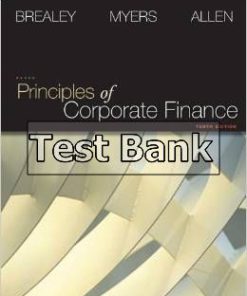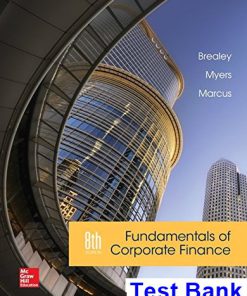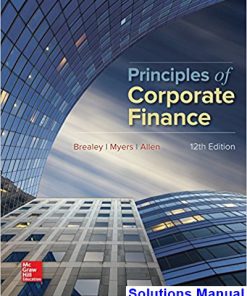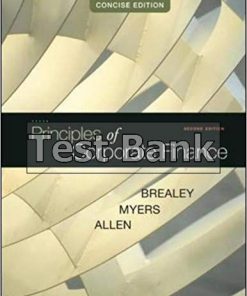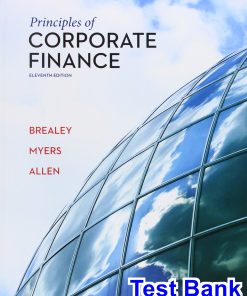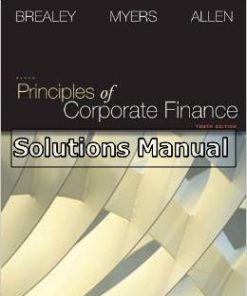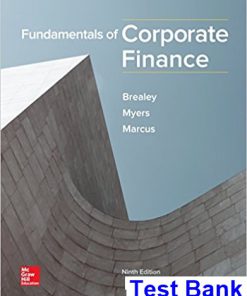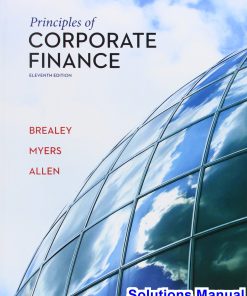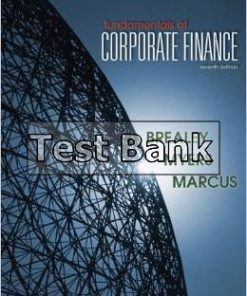Principles of Corporate Finance 12th Edition Brealey Test Bank
$50.00 Original price was: $50.00.$26.50Current price is: $26.50.
Principles of Corporate Finance 12th Edition Brealey Test Bank.
This is completed downloadable of Principles of Corporate Finance 12th Edition Brealey Test Bank
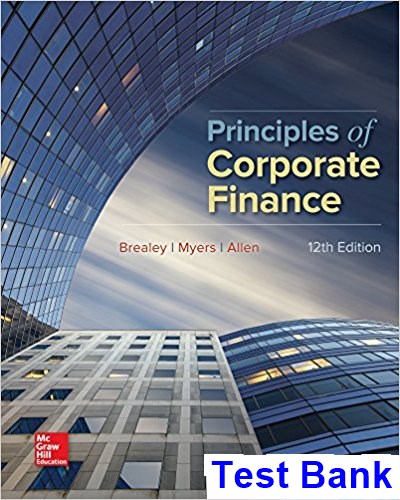
Product Details:
- ISBN-10 : 1259692175
- ISBN-13 : 978-1259692178
- Author: Stewart C. Myers, Richard A. Brealey
The integrated solutions for Brealey’s Principles of Corporate Finance have been specifically designed to help improve student performance, meaning that students are prepared for class and can successfully solve problems and analyse the results. Resources within Connect Finance provide unlimited opportunities for students to practice solving financial problems and apply what they’ve learned. Brealey’s world-leading content showing managers how to use financial theory to solve practical problems combined with a complete digital solution will help students achieve higher outcomes in the course.
Table of Content:
- Chapter1 Introduction to Corporate Finance
- 1-1 Corporate Investment and Financing Decisions
- Investment Decisions
- Financing Decisions
- What Is a Corporation?
- The Role of the Financial Manager
- 1-2 The Financial Goal of the Corporation
- Shareholders Want Managers to Maximize Market Value
- A Fundamental Result
- The Investment Trade-Off
- Should Managers Look After the Interests of Their Shareholders?
- Agency Problems and Corporate Governance
- 1-3 Preview of Coming Attractions
- SUMMARY
- PROBLEM SETS
- APPENDIX Why Maximizing Shareholder Value Makes Sense
- Chapter 2 How to Calculate Present Values
- 2-1 Future Values and Present Values
- Calculating Future Values
- Calculating Present Values
- Valuing an Investment Opportunity
- Net Present Value
- Risk and Present Value
- Present Values and Rates of Return
- Calculating Present Values When There Are Multiple Cash Flows
- The Opportunity Cost of Capital
- 2-2 Looking for Shortcuts—Perpetuities and Annuities
- How to Value Perpetuities
- How to Value Annuities
- Valuing Annuities Due
- Calculating Annual Payments
- Future Value of an Annuity
- 2-3 More Shortcuts—Growing Perpetuities and Annuities
- Growing Perpetuities
- Growing Annuities
- 2-4 How Interest Is Paid and Quoted
- Continuous Compounding
- SUMMARY
- PROBLEM SETS
- FINANCE ON THE WEB
- Chapter 3 Valuing Bonds
- 3–1 Using the Present Value Formula to Value Bonds
- A Short Trip to Paris to Value a Government Bond
- Back to the United States: Semiannual Coupons and Bond Prices
- 3-2 How Bond Prices Vary with Interest Rates
- Duration and Volatility
- 3-3 The Term Structure of Interest Rates
- Spot Rates, Bond Prices, and the Law of One Price
- Measuring the Term Structure
- Why the Discount Factor Declines as Futurity Increases—and aDigression on Money Machines
- 3-4 Explaining the Term Structure
- Expectations Theory of the Term Structure
- Introducing Risk
- Inflation and Term Structure
- 3-5 Real and Nominal Rates of Interest
- Indexed Bonds and the Real Rate of Interest
- What Determines the Real Rate of Interest?
- Inflation and Nominal Interest Rates
- 3-6 The Risk of Default
- Corporate Bonds and Default Risk
- Sovereign Bonds and Default Risk
- SUMMARY
- FURTHER READING
- PROBLEM SETS
- FINANCE ON THE WEB
- Chapter 4 The Value of Common Stocks
- 4-1 How Common Stocks Are Traded
- Trading Results for GE
- 4-2 How Common Stocks Are Valued
- Valuation by Comparables
- Stock Prices and Dividends
- 4-3 Estimating the Cost of Equity Capital
- Using the DCF Model to Set Gas and Electricity Prices
- Dangers Lurk in Constant-Growth Formulas
- 4-4 The Link Between Stock Price and Earnings per Share
- Calculating the Present Value of Growth Opportunitiesfor Fledgling Electronics
- 4-5 Valuing a Business by Discounted Cash Flow
- Valuing the Concatenator Business
- Valuation Format
- Estimating Horizon Value
- A Further Reality Check
- Free Cash Flow, Dividends, and Repurchases
- SUMMARY
- PROBLEMSETS
- FINANCE ONTHE WEB
- MINI-CASE: Reeby Sports
- Chapter 5 Net Present Valueand Other Investment Criteria
- 5-1 A Review of the Basics
- Net Present Value’s Competitors
- Three Points to Remember about NPV
- NPV Depends on Cash Flow, Not on Book Returns
- 5-2 Payback
- Discounted Payback
- 5-3 Internal (or Discounted-Cash-Flow) Rate of Return
- Calculating the IRR
- The IRR Rule
- Pitfall 1—Lending or Borrowing?
- Pitfall 2—Multiple Rates of Return
- Pitfall 3—Mutually Exclusive Projects
- Pitfall 4—What Happens When There Is More thanOne Opportunity Cost of Capital?
- The Verdict on IRR
- 5-4 Choosing Capital Investments When Resources Are Limited
- An Easy Problem in Capital Rationing
- Uses of Capital Rationing Models
- SUMMARY
- FURTHER READING
- PROBLEM SETS
- MINI-CASE: Vegetron’s CFO Calls Again
- Chapter 6 Making Investment Decisionswith the Net Present Value Rule
- 6-1 Applying the Net Present Value Rule
- Rule 1: Only Cash Flow Is Relevant
- Rule 2: Estimate Cash Flows on an Incremental Basis
- Rule 3: Treat Inflation Consistently
- Rule 4: Separate Investment and Financing Decisions
- 6-2 Example—IM&C’s Fertilizer Project
- Separating Investment and Financing Decisions
- Investments in Working Capital
- A Further Note on Depreciation
- A Final Comment on Taxes
- Project Analysis
- Calculating NPV in Other Countries and Currencies
- 6-3 Using the NPV Rule to Choose among Projects
- Problem 1: The Investment Timing Decision
- Problem 2: The Choice between Long- and Short-Lived Equipment
- Problem 3: When to Replace an Old Machine
- Problem 4: Cost of Excess Capacity
- SUMMARY
- PROBLEM SETS
- MINI-CASE: New Economy Transport (A)
- New Economy Transport (B)
- Chapter 7 Introduction to Risk and Return
- 7-1 Over a Century of Capital Market History in One Easy Lesson
- Arithmetic Averages and Compound Annual Returns
- Using Historical Evidence to Evaluate Today’s Cost of Capital
- Dividend Yields and the Risk Premium
- 7-2 Measuring Portfolio Risk
- Variance and Standard Deviation
- Measuring Variability
- How Diversification Reduces Risk
- 7-3 Calculating Portfolio Risk
- General Formula for Computing Portfolio Risk
- Do I Really Have to Add up 25 Million Boxes?
- 7-4 How Individual Securities Affect Portfolio Risk
- Market Risk Is Measured by Beta
- Why Security Betas Determine Portfolio Risk
- 7-5 Diversification and Value Additivity
- SUMMARY
- FURTHER READING
- PROBLEM SETS
- FINANCE ONTHE WEB
- Chapter 8 Portfolio Theory and the Capital Asset Pricing Model
- 8-1 Harry Markowitz and the Birth of Portfolio Theory
- Combining Stocks into Portfolios
- We Introduce Borrowing and Lending
- 8-2 The Relationship Between Risk and Return
- Some Estimates of Expected Returns
- Review of the Capital Asset Pricing Model
- What If a Stock Did Not Lie on the Security Market Line?
- 8-3 Validity and Role of the Capital Asset Pricing Model
- Tests of the Capital Asset Pricing Model
- Assumptions behind the Capital Asset Pricing Model
- 8-4 Some Alternative Theories
- Arbitrage Pricing Theory
- A Comparison of the Capital Asset Pricing Modeland Arbitrage Pricing Theory
- The Three-Factor Model
- SUMMARY
- FURTHER READING
- PROBLEM SETS
- FINANCE ON THE WEB
- MINI-CASE: John and Marsha on Portfolio Selection
- Chapter 9 Risk and the Cost of Capital
- 9-1 Company and Project Costs of Capital
- Perfect Pitch and the Cost of Capital
- Debt and the Company Cost of Capital
- 9-2 Measuring the Cost of Equity
- Estimating Beta
- The Expected Return on Union Pacific Corporation’s Common Stock
- Union Pacific’s After-Tax Weighted-Average Cost of Capital
- Union Pacific’s Asset Beta
- 9-3 Analyzing Project Risk
- What Determines Asset Betas?
- Don’t Be Fooled by Diversifiable Risk
- Avoid Fudge Factors in Discount Rates
- Discount Rates for International Projects
- 9-4 Certainty Equivalents—Another Way to Adjust for Risk
- Valuation by Certainty Equivalents
- When to Use a Single Risk-Adjusted Discount Ratefor Long-Lived Assets
- A Common Mistake
- When You Cannot Use a Single Risk-AdjustedDiscount Rate for Long-Lived Assets
- SUMMARY
- FURTHER READING
- PROBLEM SETS
- FINANCE ON THE WEB
- MINI-CASE: The Jones Family, Incorporated
- Chapter 10 Project Analysis
- 10-1 The Capital Investment Process
- Project Authorizations—and the Problem of Biased Forecasts
- Postaudits
- 10-2 Sensitivity Analysis
- Value of Information
- Limits to Sensitivity Analysis
- Scenario Analysis
- Break-Even Analysis
- Operating Leverage and the Break-Even Point
- 10-3 Monte Carlo Simulation
- Simulating the Electric Scooter Project
- 10-4 Real Options and Decision Trees
- The Option to Expand
- The Option to Abandon
- Production Options
- Timing Options
- More on Decision Trees
- Pro and Con Decision Trees
- SUMMARY
- FURTHER READING
- PROBLEM SETS
- MINI-CASE: Waldo County
- Chapter 11 Investment, Strategy,and Economic Rents
- 11-1 Look First to Market Values
- The Cadillac and the Movie Star
- 11-2 Economic Rents and Competitive Advantage
- 11-3 Marvin Enterprises Decides to Exploit a New Technology—an Example
- Forecasting Prices of Gargle Blasters
- The Value of Marvin’s New Expansion
- Alternative Expansion Plans
- The Value of Marvin Stock
- The Lessons of Marvin Enterprises
- SUMMARY
- FURTHER READING
- PROBLEM SETS
- MINI-CASE: Ecsy-Cola
- Chapter12 Agency Problems, Compensation,and Performance Measurement
- 12-1 Incentives and Compensation
- Agency Problems in Capital Budgeting
- Agency Problems and Risk Taking
- Monitoring
- Management Compensation
- Incentive Compensation
- Monitoring Pay for Performance
- 12-2 Measuring and Rewarding Performance: Residual Income and EVA
- Pros and Cons of EVA
- 12-3 Biases in Accounting Measures of Performance
- Example: Measuring the Profitability of the Nodhead Supermarket
- Measuring Economic Profitability
- Do the Biases Wash Out in the Long Run?
- What Can We Do about Biases in Accounting Profitability Measures?
- Earnings and Earnings Targets
- SUMMARY
- FURTHER READING
- PROBLEM SETS
- Chapter 13 Efficient Marketsand Behavioral Finance
- 13-1 We Always Come Back to NPV
- Differences between Investment and Financing Decisions
- 13-2 What Is an Efficient Market?
- A Startling Discovery: Price Changes Are Random
- Competition and the Efficient Market Hypothesis
- Efficient Markets: The Evidence
- 13-3 The Evidence Against Market Efficiency
- Do Investors Respond Slowly to New Information?
- Bubbles and Market Efficiency
- 13-4 Behavioral Finance
- Sentiment
- Limits to Arbitrage
- Incentive Problems and the Subprime Crisis
- 13-5 The Five Lessons of Market Efficiency
- Lesson 1: Markets Have No Memory
- Lesson 2: Trust Market Prices
- Lesson 3: Read the Entrails
- Lesson 4: The Do-It-Yourself Alternative
- Lesson 5: Seen One Stock, Seen Them All
- What If Markets Are Not Efficient? Implicationsfor the Financial Manager
- SUMMARY
- FURTHER READING
- PROBLEM SETS
- FINANCE ON THE WEB
- Chapter 14 An Overview ofCorporate Financing
- 14-1 Patterns of Corporate Financing
- Do Firms Rely Too Much on Internal Funds?
- How Much Do Firms Borrow?
- 14-2 Common Stock
- Voting Procedures
- Dual-Class Shares and Private Benefits
- Equity in Disguise
- Preferred Stock
- 14-3 Debt
- Debt Comes in Many Forms
- A Debt by Any Other Name
- Variety’s the Very Spice of Life
- 14-4 Financial Markets and Intermediaries
- Financial Markets
- Financial Intermediaries
- Investment Funds
- Financial Institutions
- 14-5 The Role of Financial Markets and Intermediaries
- The Payment Mechanism
- Borrowing and Lending
- Pooling Risk
- Information Provided by Financial Markets
- The Financial Crisis of 2007–2009
- SUMMARY
- FURTHER READING
- PROBLEM SETS
- FINANCE ON THE WEB
- Chapter 15 How Corporations Issue Securities
- 15-1 Venture Capital
- The Venture Capital Market
- 15-2 The Initial Public Offering
- Arranging an Initial Public Offering
- The Sale of Marvin Stock
- The Underwriters
- Costs of a New Issue
- Underpricing of IPOs
- Hot New-Issue Periods
- 15-3 Alternative Issue Procedures for IPOs
- Types of Auction: A Digression
- 15-4 Security Sales by Public Companies
- General Cash Offers
- International Security Issues
- The Costs of a General Cash Offer
- Market Reaction to Stock Issues
- Rights Issues
- 15-5 Private Placements and Public Issues
- SUMMARY
- FURTHER READING
- PROBLEM SETS
- FINANCE ON THE WEB
- Appendix: Marvin’s New-Issue Prospectus
- Chapter 16 Payout Policy
- 16-1 Facts About Payout
- How Firms Pay Dividends
- How Firms Repurchase Stock
- 16-2 The Information Content of Dividends and Repurchases
- The Information Content of Share Repurchases
- 16-3 Dividends or Repurchases? The Payout Controversy
- Payout Policy Is Irrelevant in Perfect Capital Markets
- Dividends or Repurchases? An Example
- Stock Repurchases and DCF Models of Share Price
- Dividends and Share Issues
- 16-4 The Rightists
- Payout Policy, Investment Policy, and Management Incentives
- 16-5 Taxes and the Radical Left
- Empirical Evidence on Dividends and Taxes
- Alternative Tax Systems
- Taxes and Payout—A Summary
- 16-6 Payout Policy and the Life Cycle of the Firm
- Payout and Corporate Governance
- SUMMARY
- FURTHER READING
- PROBLEM SETS
- Chapter 17 Does Debt Policy Matter?
- 17-1 The Effect of Financial Leverage in a Competitive Tax-Free Economy
- Enter Modigliani and Miller
- The Law of Conservation of Value
- An Example of Proposition 1
- 17-2 Financial Risk and Expected Returns
- Proposition 2
- How Changing Capital Structure Affects Beta
- Watch Out for Hidden Leverage
- 17-3 The Weighted-Average Cost of Capital
- Two Warnings
- Rates of Return on Levered Equity—The Traditional Position
- Today’s Unsatisfied Clienteles Are ProbablyInterested in Exotic Securities
- Imperfections and Opportunities
- 17-4 A Final Word on the After-Tax Weighted-Average Cost of Capital
- SUMMARY
- FURTHER READING
- PROBLEM SETS
- Mini-Case: Claxton Drywall Comes to the Rescue
- Chapter 18 How Much Should aCorporation Borrow?
- 18-1 Corporate Taxes
- How Do Interest Tax Shields Contributeto the Value of Stockholders’ Equity?
- Recasting Johnson & Johnson’s Capital Structure
- MM and Taxes
- 18-2 Corporate and Personal Taxes
- 18-3 Costs of Financial Distress
- Bankruptcy Costs
- Evidence on Bankruptcy Costs
- Direct versus Indirect Costs of Bankruptcy
- Financial Distress without Bankruptcy
- Debt and Incentives
- Risk Shifting: The First Game
- Refusing to Contribute Equity Capital: The Second Game
- And Three More Games, Briefly
- What the Games Cost
- Costs of Distress Vary with Type of Asset
- The Trade-Off Theory of Capital Structure
- 18-4 The Pecking Order of Financing Choices
- Debt and Equity Issues with Asymmetric Information
- Implications of the Pecking Order
- The Trade-Off Theory vs. the Pecking-Order Theory—Some Evidence
- The Bright Side and the Dark Side of Financial Slack
- Is There a Theory of Optimal Capital Structure?
- SUMMARY
- FURTHER READING
- PROBLEM SETS
- FINANCE ON THE WEB
- Chapter 19 Financing and Valuation
- 19-1 The After-Tax Weighted-Average Cost of Capital
- Review of Assumptions
- Mistakes People Make in Using the Weighted-Average Formula
- 19-2 Valuing Businesses
- Valuing Rio Corporation
- Estimating Horizon Value
- WACC vs. the Flow-to-Equity Method
- 19-3 Using WACC In Practice
- Some Tricks of the Trade
- Adjusting WACC when Debt Ratios and Business Risks Differ
- Unlevering and Relevering Betas
- The Importance of Rebalancing
- The Modigliani–Miller Formula, Plus Some Final Advice
- 19-4 Adjusted Present Value
- APV for the Perpetual Crusher
- Other Financing Side Effects
- APV for Businesses
- APV for International Investments
- 19-5 Your Questions Answered
- SUMMARY
- FURTHER READING
- PROBLEM SETS
- FINANCE ON THE WEB
- Appendix: Discounting Safe, Nominal Cash Flows
- Chapter 20 Understanding Options
- 20-1 Calls, Puts, and Shares
- Call Options and Position Diagrams
- Put Options
- Selling Calls and Puts
- Position Diagrams Are Not Profit Diagrams
- 20-2 Financial Alchemy with Options
- Spotting the Option
- 20-3 What Determines Option Values?
- Risk and Option Values
- SUMMARY
- FURTHER READING
- PROBLEM SETS
- FINANCE ON THE WEB
- Chapter 21 Valuing Options
- 21-1 A Simple Option-Valuation Model
- Why Discounted Cash Flow Won’t Work for Options
- Constructing Option Equivalents fromCommon Stocks and Borrowing
- Valuing the Google Put Option
- 21-2 The Binomial Method for Valuing Options
- Example: The Two-Step Binomial Method
- The General Binomial Method
- The Binomial Method and Decision Trees
- 21-3 The Black–Scholes Formula
- Using the Black–Scholes Formula
- The Risk of an Option
- The Black–Scholes Formula and the Binomial Method
- 21-4 Black–Scholes in Action
- Executive Stock Options
- Warrants
- Portfolio Insurance
- Calculating Implied Volatilities
- 21-5 Option Values at a Glance
- 21-6 The Option Menagerie
- SUMMARY
- FURTHER READING
- PROBLEM SETS
- FINANCE ON THE WEB
- MINI-CASE: Bruce Honiball’s Invention
- Chapter 22 Real Options
- 22-1 The Value of Follow-On Investment Opportunities
- Questions and Answers about Blitzen’s Mark II
- Other Expansion Options
- 22-2 The Timing Option
- Valuing the Malted Herring Option
- Optimal Timing for Real Estate Development
- 22-3 The Abandonment Option
- Bad News for the Perpetual Crusher
- Abandonment Value and Project Life
- Temporary Abandonment
- 22-4 Flexible Production and Procurement
- Aircraft Purchase Options
- 22-5 Investment in Pharmaceutical R&D
- 22-6 Valuing Real Options
- A Conceptual Problem?
- What about Taxes?
- Practical Challenges
- SUMMARY
- FURTHER READING
- PROBLEM SETS
- Chapter 23 Credit Risk and the Valueof Corporate Debt
- 23-1 Yields on Corporate Debt
- What Determines the Yield Spread?
- 23-2 The Option to Default
- How the Default Option Affects a Bond’s Risk and Yield
- A Digression: Valuing Government Financial Guarantees
- 23-3 Bond Ratings and the Probability of Default
- 23-4 Predicting the Probability of Default
- Credit Scoring
- Market-Based Risk Models
- 23-5 Value at Risk
- SUMMARY
- FURTHER READING
- PROBLEM SETS
- FINANCE ON THE WEB
- Chapter 24 The Many Different Kinds of Debt
- 24-1 Long-Term Bonds
- Bond Terms
- Security and Seniority
- Asset-Backed Securities
- Sinking Funds
- Call Provisions
- Bond Covenants
- Privately Placed Bonds
- Foreign Bonds, Eurobonds, and Global Bonds
- 24-2 Convertible Securities and Some Unusual Bonds
- The Value of a Convertible at Maturity
- Forcing Conversion
- Why Do Companies Issue Convertibles?
- Valuing Convertible Bonds
- A Variation on Convertible Bonds: The Bond–Warrant Package
- Innovation in the Bond Market
- 24-3 Bank Loans
- Commitment
- Maturity
- Rate of Interest
- Syndicated Loans
- Security
- Debt Covenants
- 24-4 Commercial Paper and Medium-Term Notes
- Commercial Paper
- Medium-Term Notes
- SUMMARY
- FURTHER READING
- PROBLEM SETS
- MINI-CASE: The Shocking Demise of Mr. Thorndike
- Appendix: Project Finance
- Chapter 25 Leasing
- 25-1 What Is a Lease?
- 25-2 Why Lease?
- Sensible Reasons for Leasing
- Some Dubious Reasons for Leasing
- 25-3 Operating Leases
- Example of an Operating Lease
- Lease or Buy?
- 25-4 Valuing Financial Leases
- Example of a Financial Lease
- Who Really Owns the Leased Asset?
- Leasing and the Internal Revenue Service
- A First Pass at Valuing a Lease Contract
- The Story So Far
- 25-5 When Do Financial Leases Pay?
- Leasing around the World
- 25-6 Leveraged Leases
- SUMMARY
- FURTHER READING
- PROBLEM SETS
- Chapter 26 Managing Risk
- 26-1 Why Manage Risk?
- Reducing the Risk of Cash Shortfalls or Financial Distress
- Agency Costs May Be Mitigated by Risk Management
- The Evidence on Risk Management
- 26-2 Insurance
- 26-3 Reducing Risk with Options
- 26-4 Forward and Futures Contracts
- A Simple Forward Contract
- Futures Exchanges
- The Mechanics of Futures Trading
- Trading and Pricing Financial Futures Contracts
- Spot and Futures Prices—Commodities
- More about Forward Contracts
- Homemade Forward Rate Contracts
- 26-5 Swaps
- Interest Rate Swaps
- Currency Swaps
- Some Other Swaps
- 26-6 How to Set Up a Hedge
- Hedging Interest Rate Risk
- Hedge Ratios and Basis Risk
- 26-7 Is “Derivative” a Four-Letter Word?
- SUMMARY
- FURTHER READING
- PROBLEM SETS
- FINANCE ON THE WEB
- MINI-CASE: Rensselaer Advisers
- Chapter 27 Managing International Risks
- 27-1 The Foreign Exchange Market
- 27-2 Some Basic Relationships
- Interest Rates and Exchange Rates
- The Forward Premium and Changes in Spot Rates
- Changes in the Exchange Rate and Inflation Rates
- Interest Rates and Inflation Rates
- Is Life Really That Simple?
- 27-3 Hedging Currency Risk
- Transaction Exposure and Economic Exposure
- 27-4 Exchange Risk and International Investment Decisions
- The Cost of Capital for International Investments
- 27-5 Political Risk
- SUMMARY
- FURTHER READING
- PROBLEM SETS
- FINANCE ON THE WEB
- Mini Case: Exacta, s.a.
- Chapter 28 Financial Analysis
- 28-1 Financial Ratios
- 28-2 Financial Statements
- 28-3 Home Depot’s Financial Statements
- The Balance Sheet
- The Income Statement
- 28-4 Measuring Home Depot’s Performance
- Economic Value Added (EVA)
- Accounting Rates of Return
- Problems with EVA and Accounting Rates of Return
- 28-5 Measuring Efficiency
- 28-6 Analyzing the Return on Assets: The Du Pont System
- The Du Pont System
- 28-7 Measuring Leverage
- Leverage and the Return on Equity
- 28-8 Measuring Liquidity
- 28-9 Interpreting Financial Ratios
- SUMMARY
- FURTHER READING
- PROBLEM SETS
- FINANCE ON THE WEB
- Chapter 29 Financial Planning
- 29-1 Links Between Short-Term and Long-Term Financing Decisions
- 29-2 Tracing Changes in Cash
- The Cash Cycle
- 29-3 Cash Budgeting
- Preparing the Cash Budget: Inflows
- Preparing the Cash Budget: Outflows
- 29-4 The Short-Term Financing Plan
- Options for Short-Term Financing
- Dynamic’s Financing Plan
- Evaluating the Plan
- A Note on Short-Term Financial Planning Models
- 29-5 Long-Term Financial Planning
- Why Build Financial Plans?
- A Long-Term Financial Planning Model for Dynamic Mattress
- Pitfalls in Model Design
- Choosing a Plan
- 29-6 Growth and External Financing
- SUMMARY
- FURTHER READING
- PROBLEM SETS
- FINANCE ONTHE WEB
- Chapter 30 Working Capital Management
- 30-1 Inventories
- 30-2 Credit Management
- Terms of Sale
- The Promise to Pay
- Credit Analysis
- The Credit Decision
- Collection Policy
- 30-3 Cash
- How Purchases Are Paid For
- Speeding Up Check Collections
- International Cash Management
- Paying for Bank Services
- 30-4 Marketable Securities
- Calculating the Yield on Money-Market Investments
- Yields on Money-Market Investments
- The International Money Market
- Money-Market Instruments
- SUMMARY
- FURTHER READING
- PROBLEM SETS
- FINANCE ON THE WEB
- Chapter 31 Mergers
- 31-1 Sensible Motives for Mergers
- Economies of Scale
- Economies of Vertical Integration
- Complementary Resources
- Surplus Funds
- Eliminating Inefficiencies
- Industry Consolidation
- 31-2 Some Dubious Reasons for Mergers
- Diversification
- Increasing Earnings per Share: The Bootstrap Game
- Lower Financing Costs
- 31-3 Estimating Merger Gains and Costs
- Right and Wrong Ways to Estimate the Benefits of Mergers
- More on Estimating Costs—What If the Target’sStock Price Anticipates the Merger?
- Estimating Cost When the Merger Is Financed by Stock
- Asymmetric Information
- 31-4 The Mechanics of a Merger
- Mergers, Antitrust Law, and Popular Opposition
- The Form of Acquisition
- Merger Accounting
- Some Tax Considerations
- Cross-Border Mergers and Tax Inversion
- 31-5 Proxy Fights, Takeovers, and the Market for Corporate Control
- Proxy Contests
- Takeovers
- Oracle Bids for PeopleSoft
- Takeover Defenses
- Who Gains Most in Mergers?
- 31-6 Mergers and the Economy
- Merger Waves
- Do Mergers Generate Net Benefits?
- SUMMARY
- FURTHERREADING
- PROBLEMSETS
- APPENDIX: Conglomerate Mergers and Value Additivity
- Chapter 32 Corporate Restructuring
- 32-1 Leveraged Buyouts
- The RJR Nabisco LBO
- Barbarians at the Gate?
- Leveraged Restructurings
- LBOs and Leveraged Restructurings
- 32-2 Fusion and Fission in Corporate Finance
- Spin-Offs
- Carve-Outs
- Asset Sales
- Privatization and Nationalization
- 32-3 Private Equity
- Private-Equity Partnerships
- Are Private-Equity Funds Today’s Conglomerates?
- 32-4 Bankruptcy
- Is Chapter 11 Efficient?
- Workouts
- Alternative Bankruptcy Procedures
- SUMMARY
- FURTHER READING
- PROBLEM SETS
- Chapter 33 Governance and CorporateControlAround the World
- 33-1 Financial Markets and Institutions
- Investor Protection and the Development of Financial Markets
- 33-2 Ownership, Control, and Governance
- Ownership and Control in Japan
- Ownership and Control in Germany
- European Boards of Directors
- Shareholders versus Stakeholders
- Ownership and Control in Other Countries
- Conglomerates Revisited
- 33-3 Do These Differences Matter?
- Risk and Short-Termism
- Growth Industries and Declining Industries
- Transparency and Governance
- SUMMARY
- FURTHER READING
- PROBLEM SETS
- Chapter 34 Conclusion: What We Doand Do Not Know about Finance
- 34-1 What We Do Know: The Seven Most Important Ideas in Finance
- 1. Net Present Value
- 2. The Capital Asset Pricing Model
- 3. Efficient Capital Markets
- 4. Value Additivity and the Law of Conservation of Value
- 5. Capital Structure Theory
- 6. Option Theory
- 7. Agency Theory
- 34-2 What We Do Not Know: 10 Unsolved Problems in Finance
- 1. What Determines Project Risk and Present Value?
- 2. Risk and Return—What Have We Missed?
- 3. How Important Are the Exceptions to the Efficient-Market Theory?
- 4. Is Management an Off-Balance-Sheet Liability?
- 5. How Can We Explain the Success of New Securities and New Markets?
- 6. How Can We Resolve the Payout Controversy?
- 7. What Risks Should a Firm Take?
- 8. What Is the Value of Liquidity?
- 9. How Can We Explain Merger Waves?
- 10. Why Are Financial Systems So Prone to Crisis?
- 34-3 A Final Word
- Appendix
- Glossary
- Index
- Back cover
People Also Search:
principles of corporate finance
principles of corporate finance 12th edition brealey
principles of corporate finance 12th edition
principles of corporate finance 12th edition testbank download pdf
principles of corporate finance 12th edition download scribd
Instant download after Payment is complete
You may also like…
Related products
Test Bank




